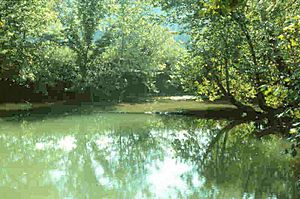Harrison Spring facts for kids
Quick facts for kids Harrison Spring |
|
|---|---|

Harrison Spring
|
|
| Lua error in Module:Location_map at line 420: attempt to index field 'wikibase' (a nil value). | |
| Type | waterbody |
| Location | Harrison County, Indiana |
| Nearest city | White Cloud |
| Area | 7 acres (2.8 ha) |
| Designated: | 1980 |
Harrison Spring is the biggest spring in the U.S. state of Indiana. You can find it in west-central Harrison County. It's close to the Blue River and just north of White Cloud.
Contents
What is Harrison Spring?
Harrison Spring is a huge natural spring. It's where underground water comes out of the ground. Scientists have studied how water flows into it. They found that a very large area of land feeds water into this spring.
How Water Reaches the Spring
A big stream called Indian Creek helps feed Harrison Spring. Sometimes, all the water from Indian Creek disappears into holes in the ground. These spots are called the Sinks of Indian Creek. This water then travels underground. About an hour later, it reappears at Harrison Spring!
The water that feeds Harrison Spring comes from a huge area. This area includes places like Corydon and Georgetown. It also includes areas east of Lanesville. All together, this underground water system covers at least 200 square miles (520 km2).
Another part of the water system is mostly hidden underground. This area stretches from Harrison Spring north to Ramsey and Central Barren. It's about 2–3 miles (3.2–4.8 km) south of Palmyra. This part of the system covers at least 39 square miles (100 km2).
The Spring's Connection to Caves
Scientists who explore caves, called cavers, have found something interesting. They map Binkley's Cave, which is the longest known cave in Indiana. Their maps show that water in one part of Binkley's Cave seems to flow under Indian Creek. This water then comes out at Harrison Spring.
Tests using special dyes have also shown this connection. Water that sinks into holes in the ground near Corydon flows through parts of Binkley's Cave. It then travels underground beneath Indian Creek. Finally, it comes out at Harrison Spring and flows into the Blue River.
It's possible there's a direct link between Harrison Spring and Binkley's Cave. However, exploring this link would mean very long underwater cave dives. No one has tried a dive like that in Indiana yet. If this connection is found, it could make both caves much longer! Binkley's Cave is already about 44 miles (71 km) long. It's the longest cave in Indiana and the seventh longest in the United States.
Brave cave divers have explored Harrison Spring itself. They have mapped thousands of feet of cave passages. All of these passages are deep underwater.
Size and Flow of the Spring
The main pool at Harrison Spring is about 120 feet (37 m) long and 95 feet (29 m) wide. It sits in an old bend of the Blue River. Divers have measured its depth to be about 45 feet (14 m).
Harrison Spring usually releases about 100 cubic feet per second (2.8 m3/s) of water. During floods, it can release up to 900 cubic feet per second (25 m3/s)! The water from the spring flows into a small stream. This stream travels about 3⁄4 mile (1.2 km) before joining the Blue River.
History of Harrison Spring
The land around Harrison Spring is privately owned. It used to be part of a large farm. This farm was about 600-acre (2.4 km2) in size. It belonged to William Henry Harrison, who later became a President of the United States. The spring is named after him.
The spring provided enough water to power two mills. These were a gristmill (for grinding grain) and a sawmill (for cutting wood). They started working in 1807, making them some of the first mills in Indiana. The farm was known as Harrison Valley. William Henry Harrison had big plans for it. However, slavery was outlawed in Indiana in 1816. This change meant he couldn't create the kind of farm he had planned.
In 1980, Harrison Spring was recognized as a National Natural Landmark. This means it's a special natural place in the United States. Even though it's a landmark, it is not open to the public.

